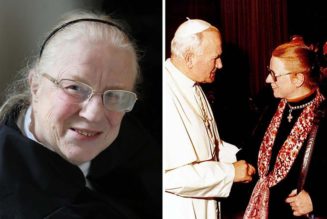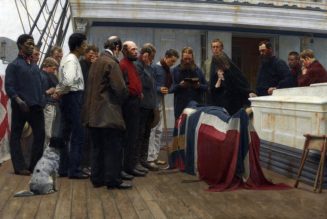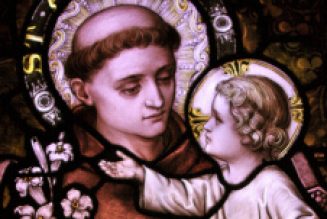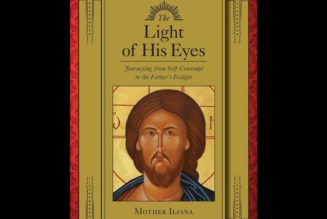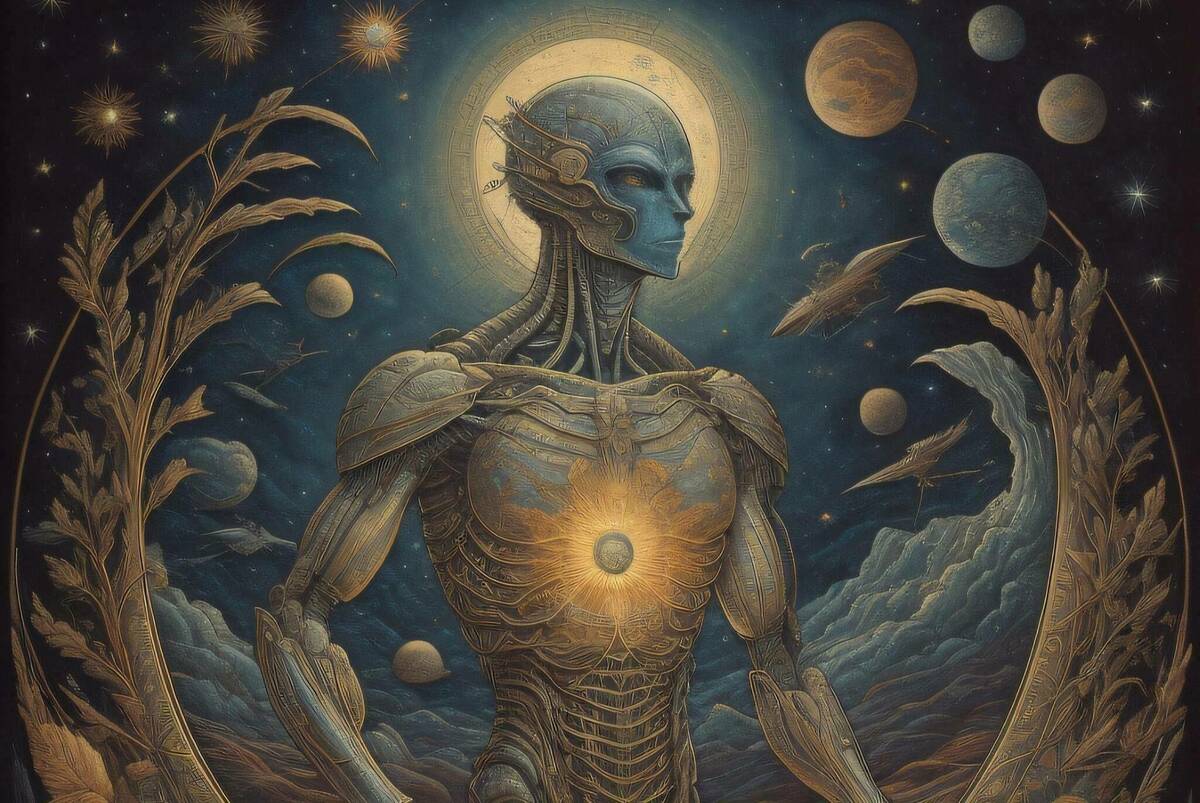
Are we, on Earth, the lone intelligent inhabitants of this vast universe? The Catholic tradition teaches us that there are other rational creatures, namely angels, who are purely intellectual, non-physical beings. But do we humans share the cosmos with any other embodied intelligent forms of life?
Today, speculation about the existence of extraterrestrial intelligence (ETI) is livelier than ever in our culture. Yet many who contribute to this intensifying interest in ETI, especially Catholics, fail to realize that the contemporary discussion is only the most recent portion of a debate in Western thought that stretches back at least twenty-six centuries. Fathers and Doctors of the Church, Catholic philosophers and theologians, popes and bishops, friars and priests, scientists and saints have all taken part in the conversation.
Ancient Greek Cosmology and the Church Fathers
The conceptual foundations for the Catholic discussion of ETI were laid in the centuries before Christ among Greek philosophers in the sixth, fifth, and fourth centuries BC. The question of intelligent life beyond earth was at that time part of a larger discussion about what came to be known as “the plurality of worlds.” This notion originally referred not so much to multiple heavenly bodies within our universe (such as stars, planets, and their moons) but rather to multiple entire universes, all coexisting independently of one another, each cosmos with its own earth and celestial bodies.
Thinkers in the Greek philosophical tradition known as “atomism” concluded that there is indeed a plurality of such worlds. Plato and Aristotle rejected that idea, but Plato thought the stars were living creatures who had each been given a soul. In this way, we might say that Plato conceived of ETI in the form of living stars who moved across the sky.
We might also note that Aristotle once speculated about inhabitants of the moon, though this idea contradicted his conception of the lunar region as part of the unchanging portion of the cosmos. In addition, followers of the sixth-century Greek philosopher and mathematician Pythagoras believed that the moon is another inhabited world, though not its own cosmos.
Early Christian thinkers were aware of the ancient discussion among pagan philosophers about the plurality of worlds. They continued the conversation, adding their own insights derived from the apostolic tradition of the Church. But they were concerned primarily with speculations about multiple entire universes, presumably inhabited. This possibility they largely rejected, following the Platonist and Aristotelian schools, which had concluded, for various philosophical reasons, that the existence of more than one universe would be somehow less “perfect” than a single cosmos.
The common Greek cosmology placed Earth at the center of the universe, with the sun, moon, and stars revolving around it. The planets (literally, “wanderers”) were simply stars that “wandered” from the path of the other heavenly bodies. This cosmological model thus had no conception of solid or gaseous spheres that could provide a home to living creatures. For this reason, the notion of ETI in the sense of inhabited planets or even moons within our universe received little if any attention from most Christian thinkers until the thirteenth and fourteenth centuries, when these long-held but pre-Christian notions came into question.
One possible exception to this position is found in a letter written by Pope St. Clement of Rome in the first century. He spoke of “the ocean, impassable to man, and the worlds beyond it,” which are regulated by God’s laws. Origen, a third-century Christian theologian with some plural-world speculations of his own, suggested two possible interpretations for Clement’s words. One was that the St. Clement might have been referring to other parts of the Earth that we cannot reach because the ocean prevents such a journey. In this sense, “worlds” would be parallel to the expression used by later, ocean-crossing explorers when they referred to Europe, Asia, and Africa as the “Old World” and the Americas as the “New World.” The second interpretation suggested by Origen was that St. Clement thought “the whole universe of existing things” contained “other worlds”; he “wished the globe of the sun or moon, and of the other bodies called planets, to each be termed ‘worlds.’” If this is the correct interpretation, then here we have what might well be the earliest surviving Christian reference to other worlds within our universe, and even to worlds with inhabitants.
We should also note that Church Fathers such as St. Jerome and St. Augustine, although not speculating about ETI (given the limits of ancient philosophy), did affirm the existence of non-human, non-angelic forms of intelligence. They both cited evidence that at least some of the creatures appearing in pagan mythology (such as satyrs or fauns) might actually exist and live on Earth, and such creatures did not seem to cause them theological difficulty. This observation is increasingly important today, when the public ETI conversation has begun broadening to include other possibilities for non-human intelligence (NHI).
Medieval Speculations
Surviving documents from the Early Middle Ages reveal very little speculation focused on the plurality of worlds, though the philosophical and theological debate about it, with its implications for the possible existence of ETI, was apparently continuing. The rediscovery of Aristotle’s work in the West made an unparalleled contribution to the flourishing of philosophy, theology, and science in the High Middle Ages (c. 1000–1300). But that philosopher’s fertile influence on medieval thinkers also brought with it certain limitations. Nowhere are these more evident than in the continuing debate about the plurality of worlds and its implications for the idea of ETI.
Following in the footsteps of Aristotle, the great Scholastic philosopher-theologians of this period—most importantly, St. Thomas Aquinas (1225–1274)—largely concluded that only one world can exist. Again, the word “world” was taken in the sense of “universe,” not earthlike planets. As we have seen, Aristotle’s geocentric model of the universe led him to conclude that the totality of things in existence has a single circumference and a single center, which is the Earth. So, there could be no possibility of another universe with a different circumference and center.
St. Thomas also drew from Plato’s thought in claiming that a singular universe resulted from a singular divine Craftsman. Because of the oneness of God, he insisted, it was fitting for him to create only one world, mirroring his own perfection. Nevertheless, again following the Greeks, St. Thomas did allow for the possibility that the stars were animated by souls, and were thus living creatures. In this way, he thought that at least one form of extraterrestrial intelligence was possible.
We must emphasize here that the ancient and medieval Christian philosophers who objected to the idea of a “plurality of worlds” were primarily doing so not on the basis of Christian revelation. They were “following the science” on this matter, and the cosmological model of the pre-Christian natural philosophy of the ancient Greeks was the closest thing they had to a science of the cosmos.
God’s Power Isn’t Limited
The Scholastic theology of St. Thomas and his scholarly allies came to dominate the universities of Europe. But three years after he died, in 1277, Étienne Tempier, the Bishop of Paris (the city where Thomas had taught), publicly condemned 219 beliefs that were popular at the universities. Étienne considered these beliefs heresies because they seemed to limit the power of God.
One of the condemned notions was that God “cannot make many worlds.” If God is all-powerful, as the Church has always taught, then who could dare claim that it would be beyond his power to make more than one universe? If he created our universe out of nothing, then surely he can create out of nothing just as many other universes as he wishes.
As a result of this public condemnation, many of the theologians of the universities were pressed to reconsider their position on the matter, and the door was open to new speculation about other worlds. Among those who engaged in such speculation, employing significant criticisms of Aristotle’s universe, were the Franciscan philosopher William of Ockham (c. 1280– 1347); the cleric Jean Buridan (c. 1295–1358), rector of the University of Paris; and Nicole Oresme (1325–1382), the Bishop of Paris. Though in the end they all concluded that there is no plurality of worlds (in the sense of multiple entire universes), their critiques helped to identify the weaknesses in the arguments of Aristotle and Aquinas that figured into the continuing conversation in the Renaissance.
Nicholas of Cusa
A remarkable thinker of the late Middle Ages was Cardinal Nicholas of Cusa (1401–1464), a German theologian, philosopher, and astronomer. He turned decisively away from the Scholastic tradition of St. Thomas and so many others, drawing more from the thought of Plato than Aristotle. And his astonishingly original conception of the cosmos broke fundamentally with ancient and medieval notions.
Cusa taught that the universe is boundless and has no center, rather than Earth being the immovable center as Aristotle and his Scholastic followers had taught. He also speculated that Earth is just one among innumerable similar planets. All the heavenly bodies, he said, even the sun, moon, and stars, are composed of the same basic elements as the Earth. For these reasons, our position in the universe is neither central nor unique. In these ideas, Cusa anticipated many of the key ideas of modern cosmology.
The Cardinal did not shy away from insisting that the celestial bodies could be inhabited or from speculating about their inhabitants:
Life, as it exists here on earth in the form of men, animals, and plants, is to be found, let us suppose, in a higher form in the solar and stellar regions. Rather than think that so many of the stars and parts of the heavens are uninhabited and that this earth of ours alone is peopled—and that with beings, perhaps, of an inferior type—we will suppose that in every region there are inhabitants, differing in nature by rank and all owing their origin to God, who is the center and circumference of all stellar regions.
In this way, Cusa declared the whole universe to be the stage for an abundance of varied life forms.
We might have expected Cusa’s rather radical break with philosophical tradition to provoke considerable opposition. Yet, his appointment as a cardinal, papal legate, and papal advisor, and his participation in the ecumenical Council of Basel (1431), all suggest that at least within the Catholic Church, he was respected and embraced by authorities at the highest levels.
ETI Original Sin, Incarnation, Redemption?
Cusa’s contemporary, the French philosopher and theologian William of Vorilong (aka Guillame de Varouillon, c. 1392–1463), joined the cardinal in pressing the bounds of the ancient conversation. He allowed not just for a plurality of worlds, but an infinity of worlds, noting that the pre-Christian atomist philosopher Democritus had posited such an infinity. Vorilong concluded that if the atheist Democritus had only understood that these worlds “lie hid in the mind of God,” rather than thinking them the result of random interaction of atoms, “he would have understood rightly.”
Contrary to the atomists, however, Vorilong suggested that such worlds could be located within our universe and that they could be inhabited (which he seemed to think probable). Then he moved to boldly go where no theologian had ever gone before. Vorilong raised a pointed question concerning these other-worldly inhabitants: Would their existence be compatible with traditional Christian teaching about original sin, the Incarnation, and redemption in Christ?
If it be inquired whether men exist on that world, and whether they have sinned as Adam sinned, I answer no, for they would not exist in sin and did not spring from Adam . . . As to the question whether Christ by dying on this earth could redeem the inhabitants of another world, I answer that he is able to do this even if the worlds were infinite, but it would not be fitting for him to go unto another world that he must die again.
Vorilong concluded, then, that since ETI would not be descendants of Adam, they would be without the original sin inherited from him. But even if they somehow had fallen as the human race did, Christ’s incarnation and redemptive sacrifice on Earth could provide them redemption. The Son of God would have the ability to be incarnate on other worlds as well, even an infinite number of times. But that scenario of an infinite series of brutal passions and deaths, he insisted, would not be fitting.
If these things are indeed true, we might wonder how we could possibly ever find out about them. Unlike most modern science fiction writers speculating about ETI, Vorilong did not envision visitors from another inhabited world traveling to ours. But he offered another possibility: “By what means are we able to have knowledge of that world? I answer by angelic revelation or by divine means.” God could tell us through angels or prophets.
By the end of the fifteenth century, then, we find that the age-old conversation about the plurality of worlds was developing a new focus. Rather than speculations about multiple entire universes, attention was turning toward multiple worlds within our universe. The notion of these other worlds being inhabited by intelligent creatures now came more to the forefront.
Late Renaissance and Early Modern Developments
Given the remarkable intellectual ferment in Western culture of the sixteenth and seventeenth centuries, a number of scientists, philosophers, and theologians entered the ETI arena of debate. Controversy sharpened as clashing scientific models, philosophies, and theologies raised the volume of the conversation, and positions on the central issues, multiplied. What led to such developments?
First, the science of astronomy was making great strides. The “heliocentric” (“sun-centered”) model of the universe, first proposed by the Greek astronomer Aristarchus of Samos in the third century BC was given new life by Nicholas Copernicus (1473–1543), a Polish mathematician, astronomer, and Doctor of Canon Law. Copernicus’s most famous work, On the Revolution of the Celestial Orbs, was dedicated to Pope Paul III (1468–1549). In it, the author laid out his arguments with confidence in “the divine providence of the Creator of all things.”
This new model, though forcefully challenged by scientists, philosophers, and theologians alike, came eventually to replace the long-established geocentric model of Aristotle and Ptolemy. It needed important modifications, but it led in the end to a more accurate understanding of our planet’s place in the solar system. It also continued to shift the focus of attention in the “plurality of worlds” debate. Rather than speculations about multiple entire universes, new theories emerged about the “worlds” that could be observed in the sky of this universe: the sun, moon, planets, and stars.
Meanwhile, philosophers were challenging more than Aristotle’s model of the cosmos, impelled by a revival of ancient ideas both from Plato and from the atomists. The driving notion behind certain arguments was the “principle of plenitude,” which was drawn ultimately from Plato’s thought. According to this principle, the universe contains all possible forms of existence, so that whatever can be, including multiple inhabited worlds, will be, and it is good that they are.
At the same time, advances in technology, most notably the telescope (invented in 1608), allowed researchers to discover more details about the heavenly bodies that were visible in the sky. Much attention was therefore devoted to comparing the physical characteristics of such bodies to those of Earth. Conclusions about their comparative composition, physical features, and environmental conditions led inevitably to speculation about their possible inhabitants.
Not surprisingly, theologians found themselves pressed to respond to both scientific and philosophical developments, some of which seemed to pose a challenge to traditional Christian beliefs. They were concerned to ensure that theology remained faithful to Sacred Scripture and Tradition. But as the Western Christian tradition was itself shattered by various Protestant movements, theologians of differing convictions debated among themselves about ETI. Catholic and other Christian thinkers proposed a variety of speculations about the subject, but the Catholic Church still took no official position on it (and has not done so to this day).
Catholic figures of those times who were open to the idea of ETI included not only Copernicus, but also such figures as Tomasso Campanella (1568–1639), a Dominican friar, theologian, and philosopher; the philosopher René Descartes (1596–1650); and the poet Alexander Pope (1688–1744). They were joined by a number of prominent Protestant figures.
The Era of the Extraterrestrial
By the mid-eighteenth century, the notion of ETI had been promoted by a number of scientists, philosophers, theologians, and poets, including some of the most prominent intellectuals of the day, both Catholic and non-Catholic. In the words of one historian, “the era of the extraterrestrial had begun.” These thinkers certainly had their opponents on the issue, but much of public opinion seemed to follow their lead.
One fascinating contribution came from the internationally known Jesuit priest, scientist, philosopher and poet Roger Joseph Boscovich (1711–1787), who taught at the Collegium Romanum and the University of Padua. Boscovich also played a major role in founding the Brera Observatory near Milan.
In his Philosophiae naturalis theoria (1758), he advanced the startling notion (based on a chemical theory about the nature of fire) that “in the sun itself, & in the stars . . . there may exist bodies . . . [that] may grow & live without the slightest injury of any kind to their organic structure.” More remarkable still was his speculation that matter consists of atoms that in addition to interacting gravitationally, as Newton had proposed, were also centers of other forces, both attractive and repulsive, which is indeed our modern understanding. Perhaps such bodies of matter, he proposed, can interpenetrate one another:
There might be a large number of material & sensible [perceptible] universes existing in the same space, separated one from the other in such a way that one was perfectly independent of the other, & the one could never acquire any indication of the existence of the other.
He elaborated:
What if there are other kinds of things that are different from those about us, or even exactly similar to ours, which have, so to speak, another infinite space, which is distant from this our infinite space by no interval either finite or infinite, but is so foreign to it, situated, so to speak, elsewhere in such a way that it has no communication with this space of ours; & thus will induce no relation of distance.
These multiple universes could in fact, he goes on to suggest, exist “in a time situated outside the whole of our eternity.”
The breadth of Boscovich’s theory is stunning: God could have created, not just intelligent life on other planets, but entire parallel inhabited universes in parallel eternities. And in a work published after his death, the theorist even considered the possibility of “a sequence of similar universes,” some of which were in size like tiny grains of sand compared to others. His vision in many ways foreshadowed today’s speculations in cosmology and physics, such as theories with extra space dimensions, “hidden sectors” of matter that do not interact (or interact very weakly) with ordinary matter, and “multiverse” scenarios.
The French Catholic philosopher Comte Joseph de Maistre (1754–1821) addressed directly and confidently the issue of Christ’s relationship to extraterrestrials. In his Soirées de Saint-Pétersbourg (1821), he criticized certain theologians who reject the notion of ETI “for fear that it disturbs the doctrine of redemption,” who instead insist that “the other planets are mere globes, destitute of life and beauty, which the Almighty has launched into space, apparently like a tennis-player, for his amusement solely.”
By the nineteenth century, and into the early twentieth century, the notion of extraterrestrial intelligence was no longer widely viewed among the well-read in Europe and the United States as an eccentric and perhaps impious speculation. In many ways it had become instead a near-dogma among astronomers, and a common assumption among many theologians as well. St. John Henry Newman (1801–1890), the English Catholic convert theologian, cardinal, and man of letters, complained in his celebrated Essay in Aid of a Grammar of Assent (1870) that in his day, in religious circles any doubts about the existence of ETI were seen as “blasphemy.”
Catholic Poets, Priests, and a Blessed
In this period, Catholic poets such as Aubrey de Vere (1814–1902) and Alice Meynell (1847–1922) wrote lyrically of ETI and their relationship to Christ. Prominent Catholic clergymen who wrote of their conviction that ETI exists were numerous and scattered across the United States, England, France, Germany, Spain, and Italy.
Among the clergy was Père Joseph Félix (1810–1891), a prominent Parisian preacher, who announced in 1863 to thousands of the Catholic faithful in Notre Dame Cathedral that the plurality of worlds was most certainly compatible with Christian beliefs. He told those scientists who saw belief in ETI as a barrier to faith: “Put into the sidereal world [the realm of the distant stars] as many populations as you please . . . Catholic dogma has here a tolerance that will astonish you and ought to satisfy you.”
In Italy, for more than two decades the pluralist position was promoted by the prolific Fr. Angelo Secchi (1818–1878), the director of the Roman College Observatory and one of the founders of astrophysics. In 1856, he noted in a work about the new Observatory:
It is with a sweet sentiment that man thinks of these worlds without number, where each star is a sun which, as minister of the divine bounty, distributes life and goodness to the other innumerable beings, blessed by the hand of the Omnipotent.
Another prominent proponent of such ideas was the German priest and seminary professor Joseph Pohle (1852–1922), who joined the founding faculty of the Catholic University of America in Washington, D.C., in 1889. Though Pohle was known among German and American seminarians primarily for his massive theological textbook, the twelve-volume Textbook of Dogmatics, in Germany he was recognized as a leading proponent of pluralism. His Star Worlds and Their Inhabitants (1884–1885) combined science and history with metaphysics and theology to consider the probability for inhabitants in various celestial bodies, including those of our solar system.
One last Catholic voice of the nineteenth century deserves mention. The celebrated German mystic and stigmatist Blessed Anne Catherine Emmerich (1774–1824) allegedly received numerous private revelations throughout her lifetime. These reportedly included visions of planets and other celestial bodies both inhabited and uninhabited, some “awaiting a future population.”
The authenticity of some elements in her writings was eventually questioned because of an editor’s work. Yet we should note that for half a century, a number of eminent Catholic theologians who examined the documents found no reason to doubt that the existence of such creatures was in accord with a traditional Christian view of the universe.
Liveliest Speculation
Before 1900, numerous publications about ETI made little effort to distinguish between scientific and religious views. But throughout the twentieth century, fewer explicitly Christian voices were heard to address the matter. As the American astronomer Carl Sagan (1934–1996), himself an agnostic, concluded with regard to the history of ETI speculation, in this field as in others, “science has systematically expropriated areas which are the traditional concern of religion.”
Nevertheless, according to the American astrobiologist Douglas Vakoch, it was at the beginning of the “Age of Space,” in the middle of the twentieth century, that a flurry of brief but provocative Christian theological speculations about ETI appeared in response to the new space exploration. One scientist of the period, the Executive Secretary of the American Rocket Society, observed that “the liveliest speculation” about ETI came from Catholic theologians.
Summing up the thought of a number of these theologians writing between 1955 and 1965, Vakoch observed: “The dominant position of this group was that belief in extraterrestrial beings is consistent with both science and Christian theology. Most of those who took a position on whether such life is probable argued that it is.” Vakoch’s survey of this decade includes references to a number of Catholic theologians (many of them priests): Theodore J. Zubek, John P. Kleinz, Daniel C. Raible, A. Carr, J. D. Conway, James Harford, John J. Lynch, L. C. McHugh, and Angelo Perego.
Among these thinkers, the most common argument for the probable existence of ETI was the glory of God. Creatures in other worlds would glorify God not just by their very existence (reflecting his greatness, love, wisdom, and power) but also by consciously and intentionally acknowledging him as their Creator. Some suggested that certain extraterrestrial races might even glorify God in a better way than we do.
One prominent twentieth-century saint firmly agreed with that idea. The celebrated Italian Capuchin priest and friar St. Pio of Pietrelcino (1887–1968), more commonly known as Padre Pio, once insisted in private conversation that “other beings” exist “who love the Lord . . . The Lord certainly did not limit his glory to this small Earth. On other planets other beings exist who did not sin and fall as we did.”
Pope Saint Paul VI (1897–1978) reportedly found the possibility of extraterrestrials to be reasonable and could see how “the universal Church” would in that case include more than the human race. And when Pope Saint John Paul II (1920–2005) was asked by a child in a public audience, “Holy Father, are there any aliens?” the saint did not respond, “That is contrary to Church teaching,” or “We don’t know.” Instead, he replied simply, “Always remember: They are children of God as we are.” Since that time, the number of Catholic theologians, philosophers, and scientists addressing the subject has multiplied. Among those who consider ETI a possibility or even a probability, and its existence not contrary to the Church’s teaching, we could include Thomas O’Meara, Marie I. George, Peter M. J. Hess, Fr. George Coyne, SJ, Fr. José G. Funes, SJ, Ernan McMullin, Fr. Roch Kereszty, Christopher T. Baglow, and others.
A Noble and Wondrous Question
In response to the current renewed interest in Unidentified Anomalous Phenomena (UAP, aka UFOs), the recently established Sol Foundation seeks to bring together “experts from academia and government to address the philosophical, policy, and scientific problems” presented by the study of UAP and the closely related topic of extraterrestrial intelligence. To their credit, the organizers of the foundation seek to include religious scholars in their studies. At Sol’s first Symposium in November of 2023, the present writer was invited to address the specific topic of ETI and the Catholic faith. When the video recording of the presentation was posted online, viewers (as expected) posted a wide variety of comments. Many expressed their approval, or at least openness, regarding its thesis: In light of Church teaching and the history of Catholic thought on the subject, we have ample reason to believe that the Church could accommodate the discovery of extraterrestrial intelligent forms of life while remaining faithful to her Tradition.
Even so, one commentator offered a terse criticism: “The Catholic Church once again is playing catch up.” These words reflect a wider sentiment found among many critics of the Faith that the Catholic Church is typically caught off guard by new scientific discoveries that are supposedly contrary to her teachings. As a result, they accuse the Church of revising its doctrine while pretending nothing has changed, as a kind of “constant rearguard action,” as Pope Benedict XVI once described it.
The highly-condensed history of the Catholic ETI conversation presented here demonstrates that in this matter, at least, the Church is by no means “playing catch up.” The Church has never issued a formal statement denying the possibility of extraterrestrial intelligence, and the reluctance of most early Catholic thinkers to entertain the matter was not based on theology, but on the mistaken assumptions of a “science” they had inherited from pre-Christian philosophers. Once those philosophical assumptions were challenged, quite a large number of prominent Catholic figures showed themselves capable of imagining the fascinating possibilities of intelligent extraterrestrial life. As we have seen, some of the resulting speculations actually anticipated certain scientific discoveries and theories of the twentieth century.
The Church has left the door wide open for Catholic scientists, as well as Catholic theologians and philosophers, to explore the topic. We should look to St. Albert the Great, the thirteenth-century patron saint of philosophers and scientists, for encouragement in this regard. He insisted: “Since one of the most wondrous and noble questions about Nature is whether there is one world or many, a question that the human mind desires to understand per se, it seems desirable for us to inquire about it.”
EDITORIAL NOTE: This article is part of a collaboration with the Society of Catholic Scientists (click here to read about becoming a member). You can ask questions and join a wider discussion of this essay at the bottom of this page where the original version of it is linked, which includes an extensive appendix.

